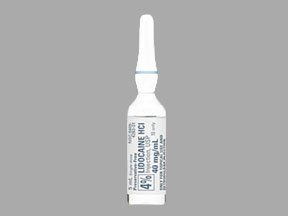
Lidocaine (pf) Coupons & Savings Card – Discount Prices from $1.01
Generic for: Xylocaine-mpf, Xylocaine-mpf +rfid, Xylocaine mpf +rfid
My prescription
Edit
5ML of 4%, Lidocaine (pf) (1 Ampule)
Select pharmacy

CVS
$23.74
COUPON PRICE
Walmart
$1.01
COUPON PRICE
Walgreens
$7.16
COUPON PRICE
Albertsons
$8.25
COUPON PRICELidocaine (pf) savings card
Show this card to your pharmacist
Walmart
$1.01
BIN
ID
PCN
GRP
019876
LH8123FB60
CHIPPO
LHX
Powered by
Lidocaine (pf) dosage forms
Dosage Quantity Price from Per unit 5ML of 4% 1 Ampule $1.01 $1.01 5ML of 4% 2 Ampules $4.29 $2.15 5ML of 4% 3 Ampules $8.93 $2.98 10ML 1 Ampule $11.11 $11.11 10ML 2 Ampules $16.02 $8.01 10ML 3 Ampules $19.53 $6.51 10ML of 2% 1 Ampule $1.01 $1.01 10ML of 2% 2 Ampules $6.53 $3.27 10ML of 2% 3 Ampules $12.29 $4.10 20ML of 1.5% 1 Ampule $4.75 $4.75
| Dosage | Quantity | Price from | Per unit |
|---|---|---|---|
| 5ML of 4% | 1 Ampule | $1.01 | $1.01 |
| 5ML of 4% | 2 Ampules | $4.29 | $2.15 |
| 5ML of 4% | 3 Ampules | $8.93 | $2.98 |
| 10ML | 1 Ampule | $11.11 | $11.11 |
| 10ML | 2 Ampules | $16.02 | $8.01 |
| 10ML | 3 Ampules | $19.53 | $6.51 |
| 10ML of 2% | 1 Ampule | $1.01 | $1.01 |
| 10ML of 2% | 2 Ampules | $6.53 | $3.27 |
| 10ML of 2% | 3 Ampules | $12.29 | $4.10 |
| 20ML of 1.5% | 1 Ampule | $4.75 | $4.75 |
| 20ML of 1.5% | 2 Ampules | $14.50 | $7.25 |
| 20ML of 1.5% | 3 Ampules | $24.24 | $8.08 |
Lidocaine (pf) Warnings
Lidocaine is a widely used local anesthetic, but its use carries certain risks that should be carefully considered. One significant concern is systemic toxicity, which can occur if excessive amounts of lidocaine enter the bloodstream. This may lead to serious central nervous system effects, including seizures, and cardiovascular issues such as irregular heartbeats. To mitigate these risks, it's crucial to adhere to recommended dosages and administration techniques.
Certain individuals may be more susceptible to lidocaine's adverse effects. Patients with severe liver or kidney disease may experience drug accumulation, increasing the potential for toxicity. Additionally, those with heart conditions like severe congestive heart failure or various forms of heart block should use lidocaine cautiously, as it can exacerbate these issues.
The U.S. Food and Drug Administration (FDA) has issued warnings about over-the-counter topical pain relief products containing high concentrations of lidocaine. When applied over large skin areas, especially on irritated or broken skin, or when the skin is covered after application, these products can lead to serious health effects, including irregular heartbeats, seizures, and breathing difficulties. Consumers are advised to avoid using such products and to follow proper application guidelines for any lidocaine-containing medications.
In summary, while lidocaine is effective for pain relief, it must be used with caution. Adhering to prescribed dosages, considering individual health conditions, and following application guidelines are essential steps to minimize potential risks associated with its use.
Lidocaine (pf) Side Effects
Lidocaine is a local anesthetic commonly used to numb specific areas of the body during medical procedures. While generally safe when administered appropriately, it can cause side effects ranging from mild to severe. Common Side Effects:
- Injection Site Reactions: Patients may experience pain, redness, swelling, or irritation at the site where lidocaine is injected.
- Sensory Effects: Temporary numbness, tingling, or burning sensations in the treated area are typical and usually subside as the anesthetic wears off.
- Mild Systemic Effects: Some individuals might feel lightheaded, dizzy, or drowsy after receiving lidocaine.
Serious Side Effects:
- Central Nervous System (CNS) Reactions: High doses or accidental intravascular injection can lead to symptoms such as nervousness, confusion, blurred vision, tinnitus (ringing in the ears), tremors, seizures, or even loss of consciousness.
- Cardiovascular Effects: Lidocaine can affect heart function, potentially causing low blood pressure, slow or irregular heartbeats, and in rare cases, cardiac arrest.
- Respiratory Issues: Severe reactions may include difficulty breathing or respiratory arrest, especially if the drug affects the respiratory centers in the brain.
- Allergic Reactions: Although uncommon, some individuals may experience allergic responses characterized by hives, swelling of the face or throat, difficulty breathing, or anaphylaxis.
- Methemoglobinemia: This rare condition involves an abnormal amount of methemoglobin in the blood, reducing its oxygen-carrying capacity. Symptoms include pale or blue-colored skin, headache, rapid heart rate, shortness of breath, lightheadedness, or fatigue.
Precautions:
- Medical History: Inform your healthcare provider if you have liver disease, heart conditions, respiratory issues, or a history of seizures, as these may increase the risk of adverse effects.
- Drug Interactions: Lidocaine can interact with various medications, including certain heart drugs, antidepressants, and other anesthetics. Ensure your doctor is aware of all medications and supplements you are taking.
- Pregnancy and Breastfeeding: If you are pregnant or breastfeeding, discuss the potential risks and benefits of lidocaine use with your healthcare provider.
When to Seek Medical Attention: If you experience severe side effects such as seizures, difficulty breathing, irregular heartbeats, or signs of an allergic reaction after receiving lidocaine, seek immediate medical attention. Always follow your healthcare provider's instructions regarding lidocaine use and report any unusual or persistent side effects promptly.
Lidocaine (pf) Interactions
When using lidocaine, it's important to be aware of potential interactions with other medications, as these can affect its safety and effectiveness. Here are some key considerations:
Local Anesthetics: Combining lidocaine with other local anesthetics can increase the risk of toxic effects. If such combinations are necessary, careful monitoring for signs of toxicity is essential.
Monoamine Oxidase Inhibitors (MAOIs) and Tricyclic Antidepressants: Using lidocaine with these types of antidepressants may lead to severe, prolonged high blood pressure. It's generally advised to avoid this combination. If concurrent use is unavoidable, close monitoring of blood pressure is required.
Ergot-Type Oxytocic Drugs: Concurrent use of lidocaine with ergot-type drugs, which are sometimes used to induce labor, can cause severe, persistent high blood pressure or even strokes. This combination should be avoided.
Nonselective Beta-Adrenergic Antagonists (Beta Blockers): Taking lidocaine with nonselective beta blockers may result in severe high blood pressure and slow heart rate. If these medications must be used together, careful monitoring of heart rate and blood pressure is necessary.
Drugs Associated with Methemoglobinemia: Methemoglobinemia is a condition where the blood can't carry oxygen effectively. Using lidocaine with certain medications can increase this risk. These medications include:
Nitrates/Nitrites: Such as Nitroglycerin and nitroprusside.
Other Local Anesthetics: Including Benzocaine, Bupivacaine, and prilocaine.
Antineoplastic Agents: Like Cyclophosphamide and Flutamide.
Antibiotics: Such as Dapsone and sulfonamides.
Antimalarials: Including chloroquine and Primaquine.
Anticonvulsants: Like Phenytoin and Phenobarbital.
Other Drugs: Such as Acetaminophen and Metoclopramide.
If you're using lidocaine alongside any of these medications, it's important to be aware of the signs of methemoglobinemia, which include pale or blue-colored skin, headache, rapid heart rate, shortness of breath, lightheadedness, and fatigue. Seek immediate medical attention if these symptoms occur.
Potent Inhalation Anesthetics: Using lidocaine with potent inhalation anesthetics during or after surgery can lead to serious heart rhythm problems. This combination should be approached with caution.
Phenothiazines and Butyrophenones: These medications may reduce or reverse the blood pressure effects of lidocaine. If they must be used together, careful monitoring is essential.
Always inform your healthcare provider about all medications you're currently taking, including over-the-counter drugs and supplements, to ensure safe and effective use of lidocaine.
